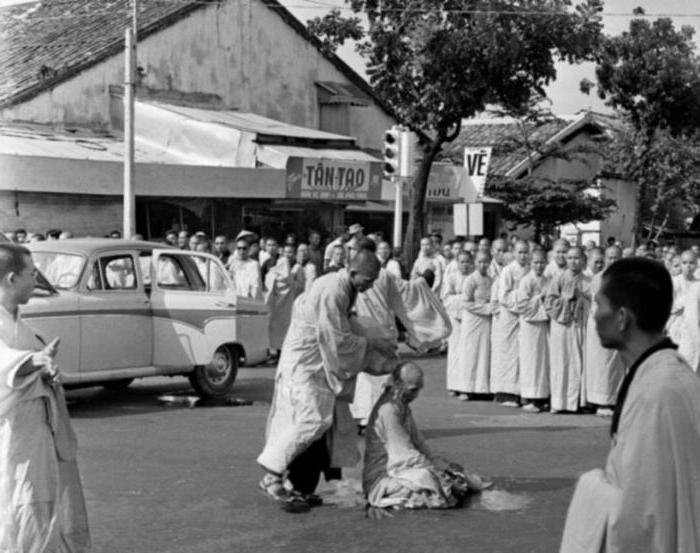Stories are known for the staggering cases when people for one reason or another decided on suicide acts, setting themselves on fire and burning them alive. This form of suicide is called self-immolation, and in most cases, the person committing it does this to say something, to draw attention to something that is very important to him. In 1963, just such an incident occurred in South Vietnam - the Buddhist monk Thich Kuang Duc committed suicide through self-immolation.
Social background
So, what was the reason why this Buddhist monk was forced to commit such an unimaginable act? Dyk's self-immolation had a political connotation and was directly related to the situation prevailing at that time in the country. It is known that at that time at least 70% (according to some sources - up to 90%) of the population of South Vietnam professed Buddhism. However, the authorities that ruled the state created conditions in which the Catholic minority had significant advantages over Buddhists. It was easier for the Catholics to advance through the ranks, they were granted numerous benefits, while the followers of the Buddha were treated as second-class people.

Buddhists fought for their rights, 1963 became an important moment in this confrontation. In May of this year, South Vietnamese authorities prevented Wesak from celebrating the Buddhist festival by using force against the crowd, resulting in the death of nine people. In the future, the situation in the country continued to heat up.
Buddhist monk self-immolation
On June 10, 1963, some American journalists working in South Vietnam learned that the next day, something important should happen opposite the Cambodian Embassy. Many did not pay attention to this message, but still several correspondents arrived in the appointed place in the morning. Then a procession of monks pulled up to the embassy, headed by Kuang Duc driving a car. The audience brought with them posters on which were written requirements for equality of faiths.
Then the Buddhist monk, whose self-immolation was planned and prepared in advance, took a meditative posture, and one of his companions took a can of gas from the car and poured its contents onto his head. Quang Duc, in turn, recited the “Memorial of the Buddha,” after which he set fire to himself with the help of matches. The policemen gathered at the venue of the rally tried to approach the monk, but the clergy escorting Kuang Dyk did not let anyone in, forming a living ring around.
Eyewitness
This is what David Halberstem, a journalist for The New York Times, who observed the act of self-immolation, said: “I guess I should have seen this spectacle again, but once it was more than enough. The man burned in flames, his body shriveled and turned into ashes, and my head was black and charred. It seemed that all this was happening slowly, but at the same time I saw this man burn out quickly enough. The smell of burning human flesh, the sobs of the gathered around the Vietnamese ... I was in a state of shock and could not cry I was confused I was so puzzled that I couldn’t ask questions or write something down. What can I say - I couldn’t even think. It seemed that self-control was available only to a burning monk who had not moved and never moved all this time made a single sound. "
The funeral
The funeral of a Buddhist monk was scheduled for June 15, but later on the date was moved to the 19th. Until that moment, his remains were in one of the temples, from where they were later transferred to the cemetery. Interestingly, the body of Kuang Dyk was cremated, but the fire did not touch his heart, which remained intact and was recognized as a shrine. A Buddhist monk, whose self-immolation was performed in order to achieve goals common to all Buddhists, is recognized as a bodhisattva, that is, a person with an awakened consciousness.
Subsequently, the authorities in South Vietnam went into confrontation with the adherents of Buddhism. So, in August, security forces attempted to confiscate the relics left after the death of Quang Duc. They managed to seize the monk’s heart, but they couldn’t take possession of his ashes. However, the Buddhist crisis, which marked 1963, soon ended after the military staged a coup and overthrew President Zyem.
Conclusion
Malcolm Brown, one of the journalists present at the site of the self-immolation of a Buddhist monk, managed to take several photos of what was happening. These pictures were placed on the front pages of the world's largest newspapers, so the incident had a great political effect. Ultimately, the people of South Vietnam achieved recognition of their rights, and the Buddhist monk, whose self-immolation was committed for the common good, became a national hero.